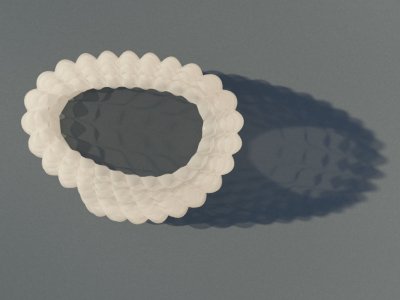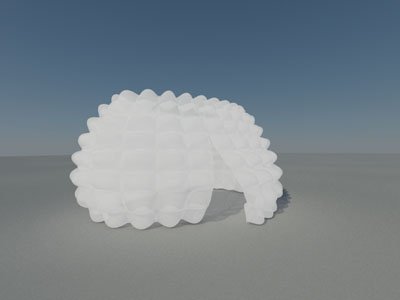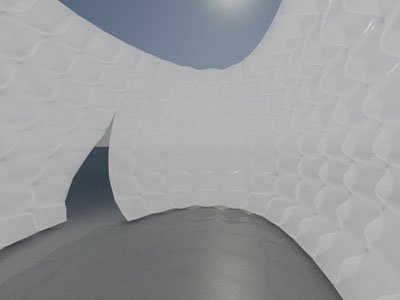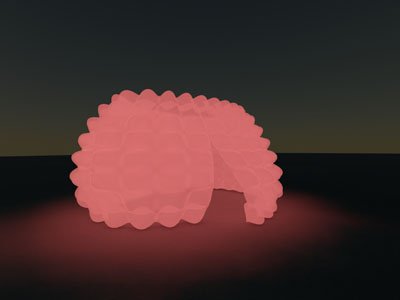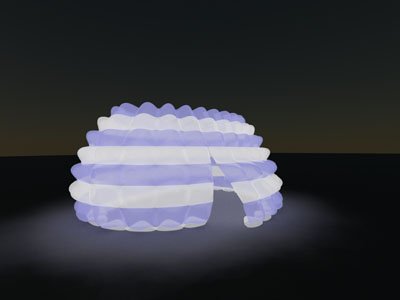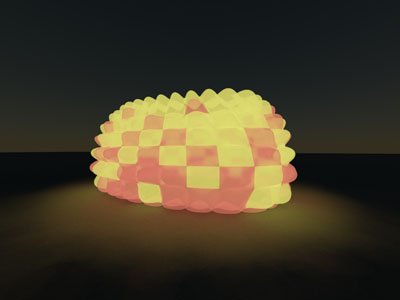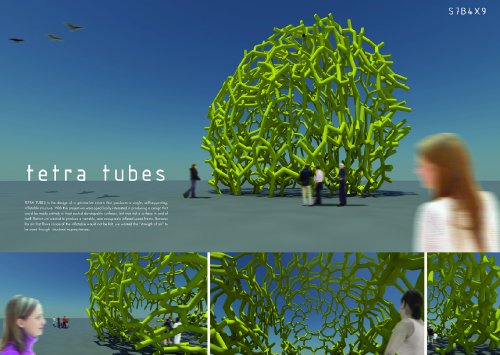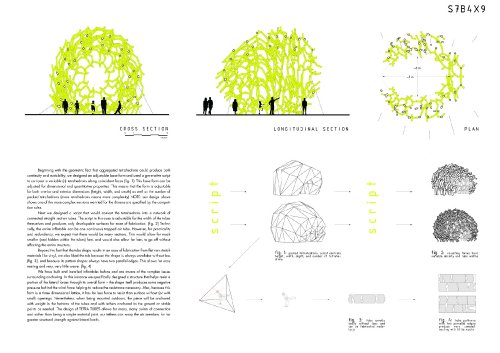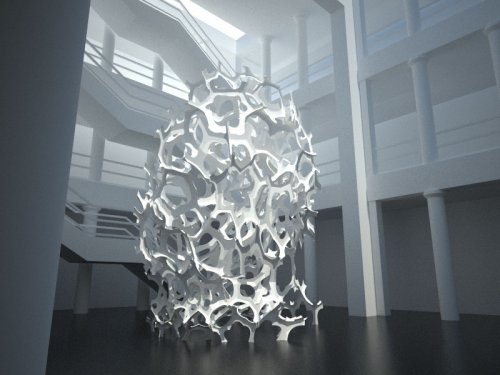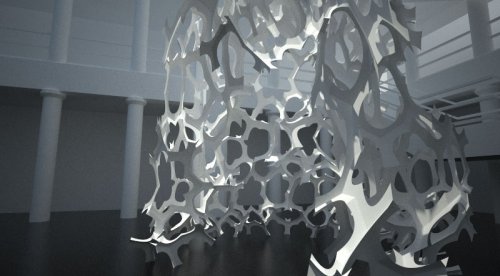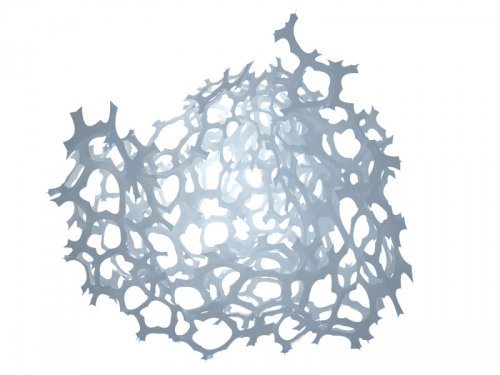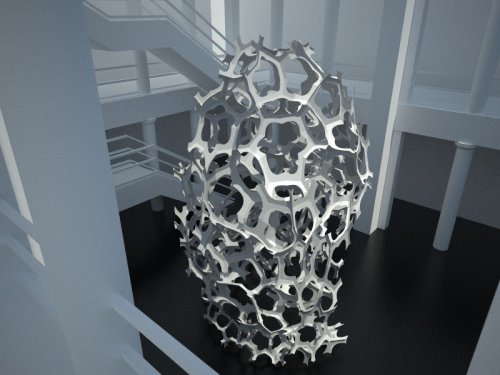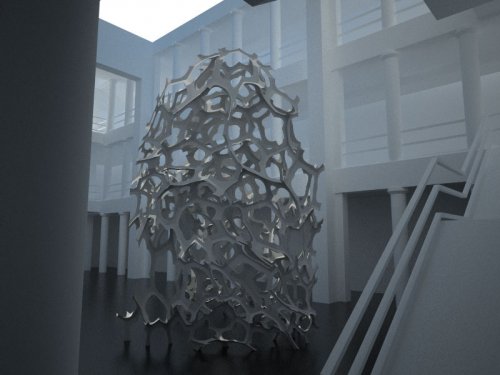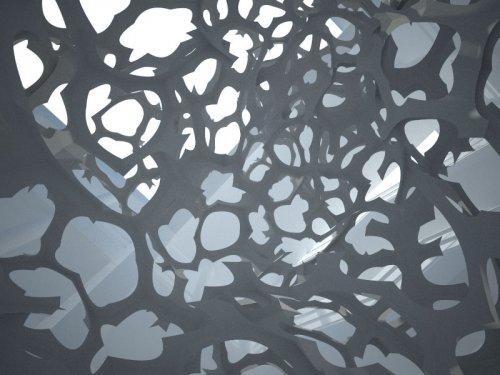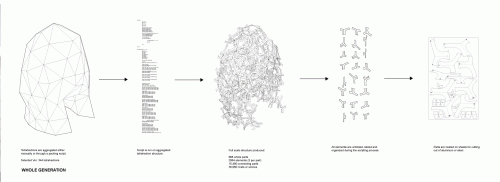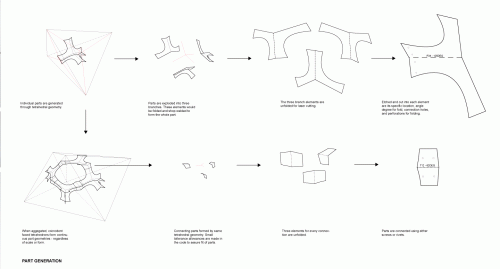Posts Tagged ‘competition’
[.. author markup ..] [.. date markup ..]The Lean Years | 99k House
Monday, March 21st, 2011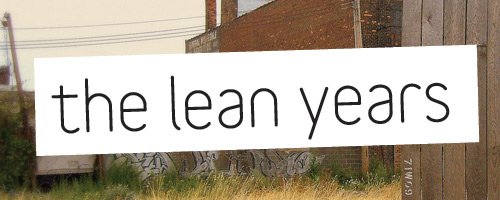
Glenn recently presented area’s 99k House project at The Lean Years conference held at the University of Michigan from March 18-19. The project was also part of an exhibition in the college gallery which coincided with the conference. Below are renderings of the project produced specifically for the exhibit. More info on the project can be found in the projects area of the site.
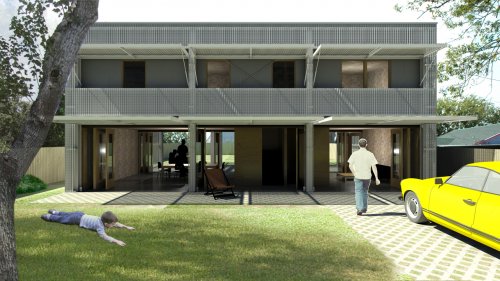
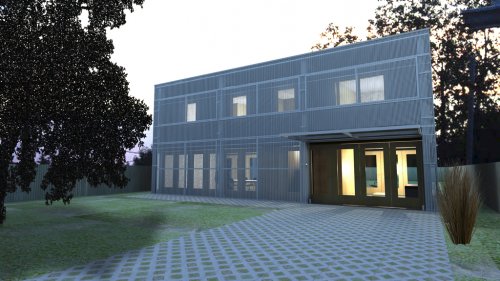
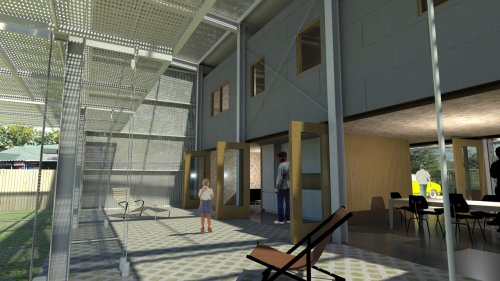
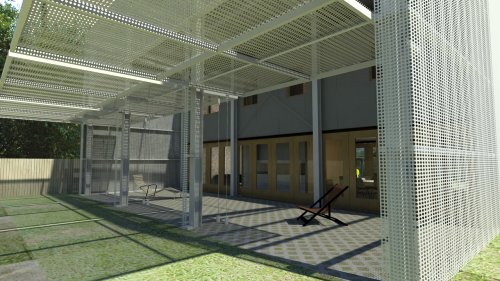
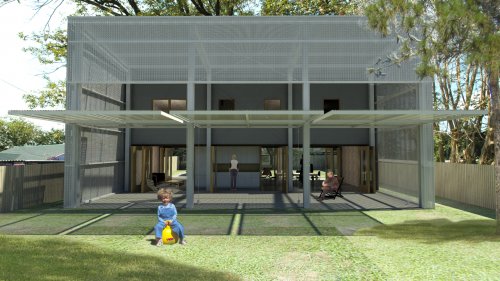
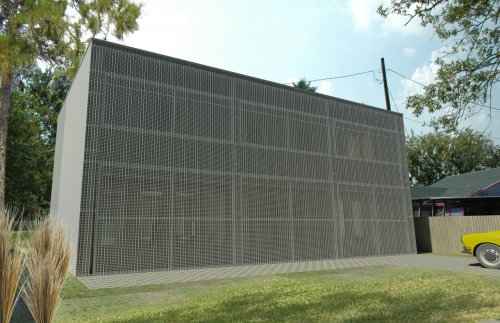
tetra | n – Runner Up TEX-FAB Competition Entry
Friday, November 19th, 2010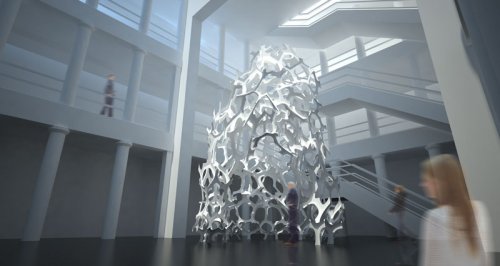
Our Runner-Up entry to the 2010 TEX-FAB Repeat design competition.
tetra | n project is based on the desire to design a generative
self-supporting structure capable of variable form – through utilizing a
single robust detail – one which could be fabricated out of flat stock
material. tetra | n project accomplishes this through two means. First is
the development of part geometry based on a tetrahedron (see diagram) –
structured in this way – the generation of more complex geometry through
simple base geometry always produces well – formed planar objects.
Additionally, coincident faces of adjacent tetrahedrons always produce
continuous forms – joints always meet correctly – regardless of the
position or scale of the next part. Secondly – through the utilization of
Rhinoscript – highly complex variable formed structures of n tetrahedrons
are possible. The script is ‘run’ on an assembled tetrahedral base
structure – part generation, connective element generation, labeling,
drill holes, and part flattening are integral functions of the script.
tetra | n is formed as a single unified tower structure with an occupiable
base that supports itself simply by standing on the ground. Depth and
redundancy in the form develop not only a robust structure – but a level
of complexity and intricacy found only in organic forms. The visual effect
is of a structure that is, on the one hand, highly ordered, rigorous and
geometric, and on the other degenerates into near chaos, simulates organic
growth, and confounds clear distinctions between foreground and background.
Sukkah City Competition
Thursday, September 16th, 2010Below are our two entries for the Sukkah City design competition. All of the entries and winning designs can be viewed through the competion site – sukkahcity.com The twelve selected designs are still under construction – but should be completed soon – with the ultimate winner choosen by the public.
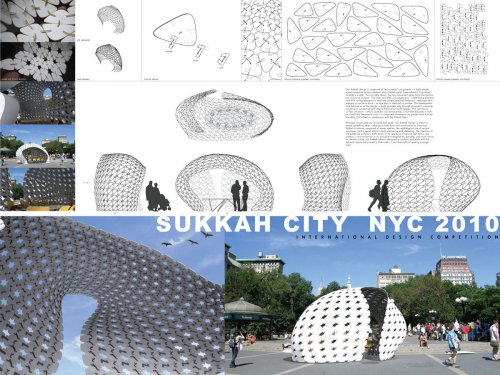
This Sukkah design is composed of two essential components – a light weight wood composite surface element and a folded metal frame element. Connected through a single – but variable detail, the two component types form one continuous structural surface. The laser and CNC cut components: 1,048 frame elements and 672 surface elements in total are joined by 4,032 fasteners. Although each element is similar in kind – no one part is identical to another. The development and fabrication of the design is made possible only through parametric computer scripting in connection with digital fabrication technologies. This continuous surface structure – which could be considered either a roof that becomes a wall or a wall that becomes a roof – is composed of elements no greater than 4 handbreadths (16 inches) in compliance with the Talmud laws.
Although constructed out of wood and metal– our Sukkah design is meant to evoke something other – eluding in both form and construction to historical Sukkah structures composed of woven textiles, the mythological use of animal carcasses, and a vessel which is both welcoming and sheltering. The intention of the patterned surface is both iconic in its reference to natural leaf forms, star patterns – and utilitarian in its structural triangulation, porosity, and ocular focus on the sky. Lastly, our Sukkah table is designed to conform and work with the dynamic space and present a democratic / non-hierarchical seating arrangement.
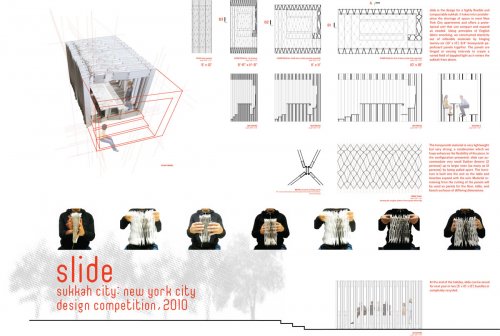
slide is the design for a highly flexible and compactable sukkah. It takes into consideration the shortage of space in most New York City apartments and offers a prototypical unit that can compact and expand as needed. Using principles of English fabric smocking, we constructed elasticity out of inflexible materials by hinging twenty-six (10’ x 12’) ¾”honeycomb paperboard panels together. The panels are hinged at varying intervals to create a varied field of dappled light as it enters the sukkah from above. The honeycomb material is very lightweight but very strong, a combination which we hope enhances the flexibility of the piece. In the configuration presented, slide can accommodate very small Sukkot dinners (2 persons) up to larger ones (as many as 12 persons) by being pulled apart. The furniture is built into the unit so the table and benches expand with the unit. Material remaining from the cutting of the panels will be used as panels for the floor, table, and bench surfaces of differing dimensions. At the end of the holiday, slide can be saved for next year in two (5’ x 10’ x 12’) bundles or completely recycled.
lay ground
Tuesday, July 20th, 2010Our proposal for the 2010 addition of DesCours in New Orleans. We are proposing to fabricate a contoured landscape utilizing EPS foam cut by a computer controlled robotic hotwire. The landscape would be covered in sod and is designed to facilitate public gathering and lounging. Luminaires are installed and eminate light from select slits in the surface. The final proposal would conform to the specific constraints of an assigned site. EPS foam – and not to mention sod are 100% recycleable materials. The competition will be decided in mid-august. Our complete proposal can be viewed here.
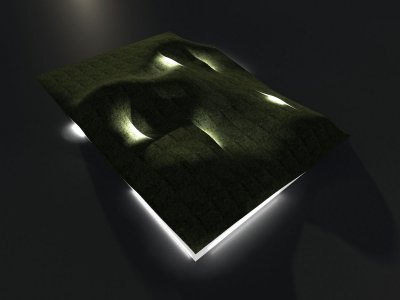
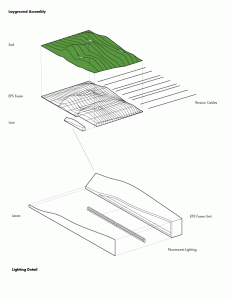
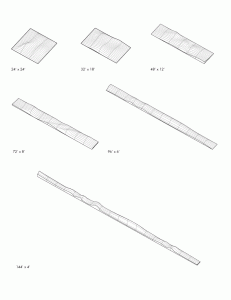
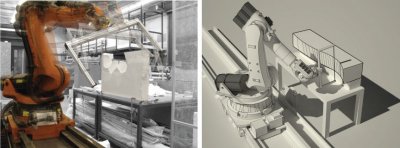
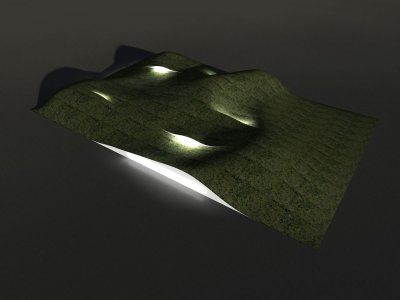
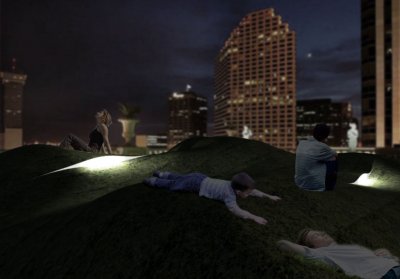
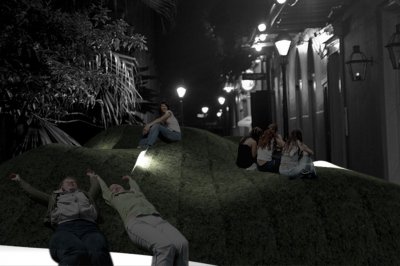
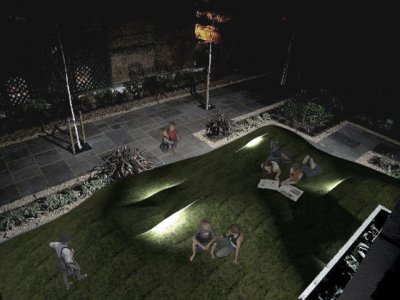
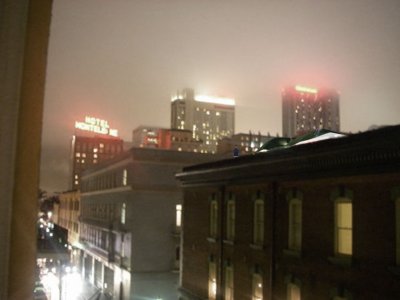
mediascape
Monday, June 28th, 2010Just a few images of a recently printed 3D model of an older project – ‘mediascape.’ Full description in the project section of the site. This is an ABS plastic print – which was essential in getting the thin edge of the form. We are pushing the maximum thiness with the edge being only 0.04″. The first time we tried to print this was on a starch printer and the model just disintegrated. A future plan is to do a ribbed structural model at a larger scale. This model measures about 8″ x 5″.
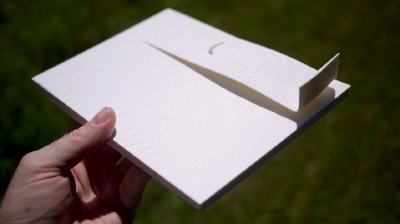
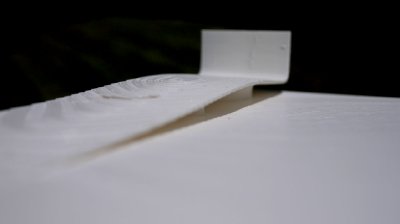
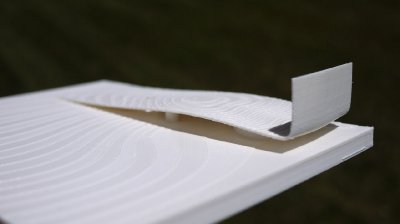
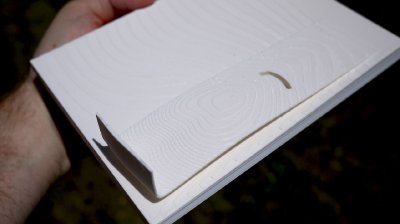
atlantic city holocaust memorial
Wednesday, June 16th, 2010Below is the board for our most recent competition – the Atlantic City Holocaust Memorial. No luck in this one – it was a stretch with 715 entries – but we were happy with what we came up with and thought it was appropriate for the site. Still waiting to see the boards of the first round finalists – not sure what they were looking for. Here is our explanation for our project:
Based on the assumption that the horrific events of the holocaust are too incomprehensible to be characterized through symbolic representation, our memorial creates a condition that orients and dis-orients the viewer – creating an experience that is at once contemplative and disturbing. The design aim is to construct a series of spaces that visually collapse into each other, activating and implicating traditionally passive viewers in their memorialization of the Holocaust. Conceptually, we imply that we are all responsible for each others’ well being and violations. Our memorial asks viewers, through reflection, to see other in place of themselves.
Our memorial creates a wall that is at once there and not there. The wall is composed of a series of wedged shaped pillars whose inner faces are polished mirrored surfaces – creating a periscopic see-through effect – dematerializing the wall and in the process reflecting the viewer, others, and fragments of the context – relationships that constantly evolve as one both passes by and engages the monument. Upon the outer surfaces of the pillars are embossed in raised letters all possible combinations of one, two, and three letter initials – demarcating all people that are lost, present, and to be.
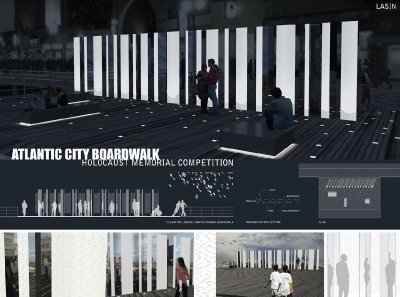
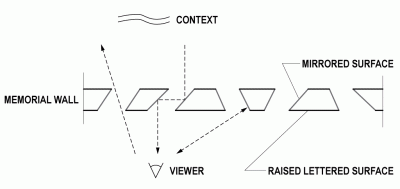
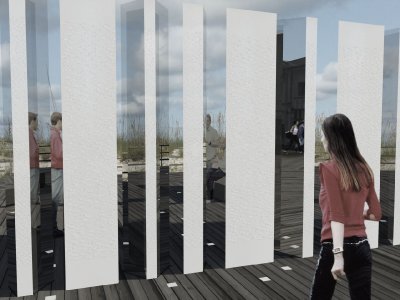
triangular blooms
Friday, May 21st, 2010area’s competition entry Triangular Blooms awarded top ten in the 10up Atlanta design competition. Rhinoscripting was utilized in developing the design and for connecting it directly with fabrication technologies. The proposal was for a thin shell vault composed of over 500 different plywood and steel elements. The competition brief asked for projects under a $5000.00 budget that could be built in several weeks and assembled on site in 24hrs. We wrote the script with the aim of randomizing the ordering grid of vault – creating variability of the parts – within a certain range. Our friends from UMich Wes Mcgee, David Pigram, Brandon Clifford, and Matt Johnson won with their outrageous 60 foot foam tower – which they are constructing – as I write this. Our boards below:
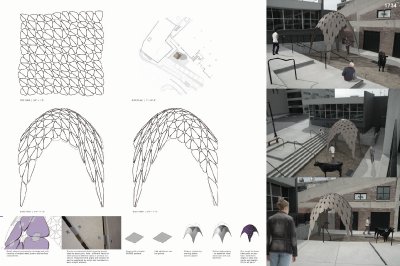
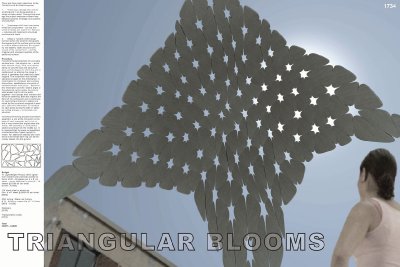

illume
Monday, October 26th, 2009This was certainly the summer of the inflatable. A few pics of our ill-fated entry into the 2009 DesCours Competition - but we aren’t bitter…Would have been constructed out of poly-ethelene with a sub-structure of fiberglass rods – similar to modern tent construction. The plan was to explore the use of arduino controllers to manipulate multi-colored led lights imbedded in the inflatable ‘units.’ Cheap – high impact – portable on a plane. Well – it was a great opportunity to explore Rhinos new kickass version of paneling tools.
